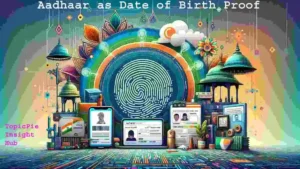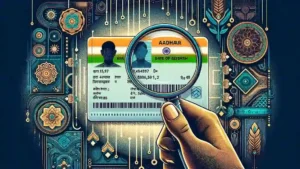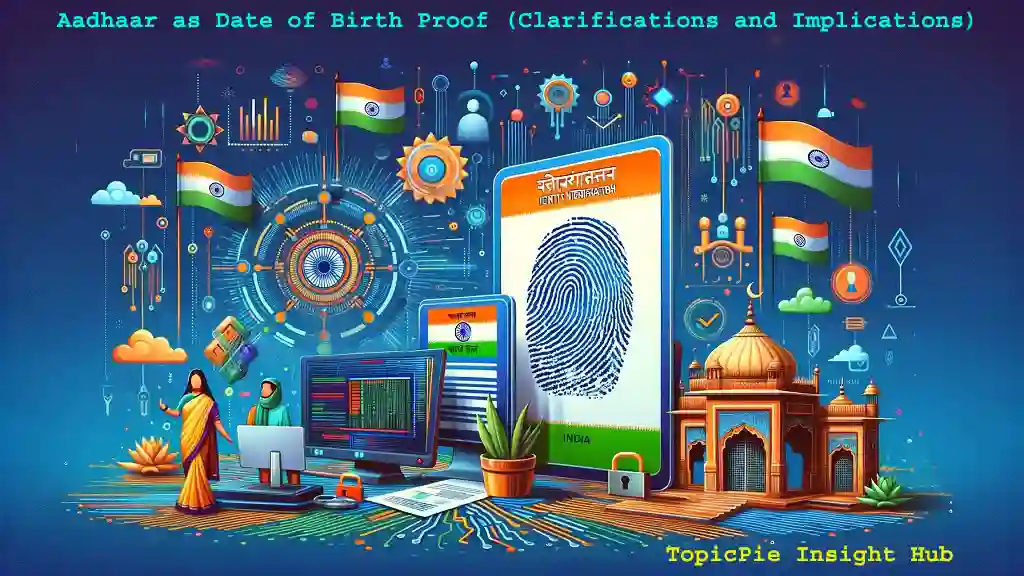Aadhaar has revolutionized identity verification in India, becoming a cornerstone for various legal and financial processes. This unique identification number, linked to an individual’s biometric data, ensures accurate recognition across countless services. Its role extends beyond mere identification, embedding itself deeply into the daily lives of citizens. Recently, the use of Aadhaar as Date of Birth Proof has sparked discussions and deliberations. This aspect of Aadhaar’s application highlights its significance in verifying not just identity but also age, an essential factor in many administrative and legal procedures. The topic of Aadhaar as Date of Birth Proof opens a window into understanding its multifaceted utility and the implications of its use in this specific context. As we delve into this subject, we explore the nuances of Aadhaar’s role in age verification and the broader impacts of its implementation across various sectors.
The Role of Aadhaar as Date of Birth Proof in Identity Verification:
The Inception and Purpose of Aadhaar
Aadhaar began as a visionary project, aimed at providing a unique identity to every Indian resident. Its core purpose was to eliminate duplicate identities and ensure accurate delivery of government services. Launched by the UIDAI, Aadhaar quickly became a foundational element in India’s digital infrastructure. It streamlined processes, making it easier for citizens to access various services and benefits. Importantly, Aadhaar’s biometric features brought unparalleled security to identity verification, setting a new standard nationwide.
Expansion to Date of Birth and Identity Verification
As Aadhaar’s usage grew, so did its applications. “Aadhaar as Date of Birth Proof” became a common phrase among Indians. This expansion allowed individuals to use their Aadhaar card not just as an identity proof, but also to verify their age. Such a move was crucial for accessing age-restricted services and benefits, from government pensions to opening bank accounts. This versatility of Aadhaar enhanced its value, making it an indispensable part of daily life. The UIDAI’s efforts to include date of birth verification further cemented Aadhaar’s role as a multifaceted tool for identity authentication across India.
Deciphering UIDAI’s Guidance on Aadhaar as Date of Birth Proof:

The Unique Identification Authority of India (UIDAI) has revisited the use of Aadhaar as Date of Birth Proof. This section delves into UIDAI’s position and the broad implications of its advisory.
UIDAI’s Stance on Aadhaar as Date of Birth Proof
UIDAI emphasizes Aadhaar’s primary role as identity verification, not specifically as date of birth proof. The authority suggests that while Aadhaar contains date of birth information, it should not be the sole document for age verification. This stance encourages a risk-based assessment approach. UIDAI aims to ensure that Aadhaar remains a robust tool for identity verification without overreliance on it for age-specific details. This nuanced position reflects a commitment to maintaining Aadhaar’s integrity as a secure and versatile identification system.
Implications of the Advisory for Individuals and Agencies
The advisory has significant implications. For individuals, it means diversifying the documents used for age verification, potentially affecting ease of access to services and benefits. People may need to present additional or alternative proofs of age, such as birth certificates or passports, especially in critical services where age accuracy is paramount.
For agencies, both governmental and private, this advisory necessitates a revision of verification protocols. They must adapt to a broader acceptance of documents for age verification, impacting processes like KYC in banking, enrollment in government schemes, and more. This shift aims to enhance the verification process’s security and inclusivity, acknowledging the complexity of identity verification in today’s digital age. Agencies are now tasked with balancing efficiency and compliance, ensuring that services remain accessible while adhering to the updated guidelines.
Navigating the New Guidelines:
Risk-Based Assessment Explained
Aadhaar, as a tool for verifying identity, now undergoes a nuanced shift. Agencies must perform a risk-based assessment when using Aadhaar as Date of Birth Proof. This method involves weighing the risks and benefits carefully. For instance, agencies will consider the likelihood of inaccuracies in Aadhaar data and decide how critical accurate age information is for their services.
Firstly, this approach ensures a tailored application of Aadhaar, enhancing security and reliability. Secondly, it prompts agencies to evaluate their processes, fostering a more secure use of data. Ultimately, this shift aims to balance efficiency with the need to protect individual identities.
Alternative Documents for Age Verification
Following the UIDAI’s guidance, there’s a pivot towards alternative documents for verifying age. This move acknowledges that Aadhaar, while pivotal, is part of a broader ecosystem of identity verification. Documents like birth certificates, school-leaving certificates, passports, and driving licenses now gain increased importance.
Each document offers unique advantages. Birth certificates provide unequivocal proof of age, while passports and driving licenses bring added layers of verification, such as photographs and signatures. This diversity in documentation ensures that individuals have multiple avenues to prove their age, enhancing the inclusivity and flexibility of identity verification processes.
Impact Across Sectors:
Effect on Government Welfare Schemes
The update regarding “Aadhaar as Date of Birth Proof” has profound implications for government welfare schemes. Primarily, it necessitates a reassessment of beneficiary verification processes. Traditionally, Aadhaar streamlined the identification of recipients, ensuring that benefits reached the right hands efficiently. Now, agencies must pivot towards incorporating other documents for age verification. This shift, although challenging, also presents an opportunity to enhance data accuracy and security. Importantly, it emphasizes the need for flexibility in verification processes, ensuring that no beneficiary is inadvertently excluded from receiving crucial support due to documentation issues.
Moreover, this transition may lead to temporary disruptions as systems adapt. However, the long-term benefits include a more inclusive approach to verification, catering to individuals who might have faced difficulties in providing Aadhaar as sole proof. Government entities are thus tasked with updating their protocols, a move that will likely improve the robustness of welfare distribution mechanisms over time.
Changes in the Banking Sector’s KYC Processes
Similarly, the banking sector faces significant changes in its KYC (Know Your Customer) processes due to the new guidelines on “Aadhaar as Date of Birth Proof.” Banks have relied heavily on Aadhaar for not just establishing identity but also for verifying customers’ ages. With the need to shift towards alternative documents for age verification, banks and financial institutions are revising their KYC frameworks. This adjustment means more than just accepting additional documents; it’s about ensuring these alternatives are integrated seamlessly into digital platforms and verification systems.
This change aims to uphold the integrity and security of financial transactions while maintaining customer convenience. For instance, banks might now require a birth certificate, passport, or school leaving certificate as part of their KYC documentation. Such a move, though initially requiring an uptick in administrative effort, is poised to enhance the accuracy of customer data.
Furthermore, the adaptation process includes training staff to recognize and process a broader range of documents. It also involves updating digital systems to accommodate new data types. Ultimately, this evolution in KYC practices underscores the banking sector’s resilience and its commitment to compliance and customer service in the face of regulatory changes.
Strategies for Compliance and Adaptation

Adapting to Aadhaar’s New Role
With the Unique Identification Authority of India (UIDAI) refining Aadhaar’s application, adapting to its new role is essential. “Aadhaar as Date of Birth Proof” now demands a nuanced approach. Agencies and individuals must recognize Aadhaar’s evolving utility in identity verification. This entails a shift towards a broader documentation strategy. Incorporating alternative proofs, like birth certificates and passports, alongside Aadhaar, ensures comprehensive identity validation. Additionally, embracing digital verification tools can streamline processes. This adaptability not only aligns with regulatory changes but also enhances the integrity of identity verification, keeping it secure and user-friendly.
Ensuring a Smooth Transition for Users
For a seamless transition in using “Aadhaar as Date of Birth Proof,” clear communication is key. Agencies should inform users about the updated guidelines and the necessity of additional documents for age verification. Offering guidelines and checklists can demystify the process, making it more accessible. Training customer service teams to address queries related to Aadhaar and age verification will further ease the transition. Moreover, implementing feedback mechanisms helps in identifying and rectifying challenges faced by users. Such proactive measures ensure that the transition is not just smooth but also reinforces trust in Aadhaar’s role in identity verification, making it a positive experience for all stakeholders.
Conclusion:
As we explore the future of “Aadhaar as Date of Birth Proof,” it’s clear that adaptability and compliance will be key. The UIDAI’s advisory marks a pivotal moment, urging a shift towards more nuanced verification methods. This change, while significant, opens up opportunities for strengthening the integrity of identity verification in India. Agencies and individuals alike must embrace these guidelines, ensuring that Aadhaar continues to serve its purpose effectively and securely.
Moreover, the adaptability required by these new guidelines isn’t just a challenge; it’s an invitation to innovate. By diversifying the documents accepted for verifying age and embracing risk-based assessments, we can enhance the reliability of our identity verification processes. This journey towards compliance is not just about adhering to regulations. It’s about contributing to a more secure, inclusive, and efficient system of identity verification that benefits everyone.
Embracing these changes with a positive outlook and a willingness to adapt will be crucial. Together, we can ensure that Aadhaar remains a cornerstone of India’s digital infrastructure, facilitating access to services and benefits while protecting individuals’ privacy and rights. The road ahead may require adjustments, but with a collaborative approach, the future of Aadhaar as Date of Birth Proof looks promising.
FAQs on Aadhaar as Date of Birth Proof:
1. Can Aadhaar still be used as proof of date of birth? Yes, Aadhaar can be used as proof of date of birth, but agencies may require a risk-based assessment or additional documents to verify age accurately due to recent UIDAI advisories.
2. What changes did the UIDAI make regarding Aadhaar as proof of age? The UIDAI issued advisories suggesting a more cautious approach to using Aadhaar for age verification. It encourages entities to perform risk-based assessments and consider alternative documents for more precise age verification.
3. What are alternative documents for verifying date of birth? Alternative documents for verifying date of birth include birth certificates, passports, school-leaving certificates, and driving licenses. These documents may be requested alongside or instead of Aadhaar for certain services or benefits.
4. How does the new guideline affect government welfare schemes? Government welfare schemes may adjust their verification processes to align with the UIDAI’s guidelines, ensuring beneficiaries’ ages are verified accurately without causing inconvenience or delays in service delivery.
5. Will these changes affect the KYC process in banks? Yes, banks and financial institutions may revise their KYC processes to incorporate additional or alternative documents for age verification, following the UIDAI’s advisory to ensure compliance and maintain the integrity of customer data.
6. How can individuals prepare for these changes? Individuals should ensure they have access to alternative age verification documents and stay informed about the specific requirements of services and benefits they use. Keeping these documents readily available will help smooth any transitions.
7. Are there any exceptions to using Aadhaar as date of birth proof? Specific cases or services might still accept Aadhaar as sufficient proof of date of birth, especially where risk assessment deems it appropriate. However, it’s best to check with the concerned agency or service provider for their current requirements.
8. What is a risk-based assessment in the context of Aadhaar verification? A risk-based assessment involves evaluating the potential risks and implications of relying on Aadhaar for age verification. Agencies consider the accuracy and reliability of the data, the context of the service, and the consequences of any inaccuracies to decide whether Aadhaar alone is sufficient.
By staying informed and prepared, individuals and agencies can navigate these changes effectively, ensuring that Aadhaar continues to serve as a valuable tool for identity verification while complying with the latest guidelines and safeguarding personal information.
You may also like to read: Understanding Voltage Regulator: A Comprehensive Guide











It’s an amazing piece of writing designed for all the internet viewers; they will obtain advantage from it I am sure.
Hello! I simply wish to offer you a huge thumbs up for the excellent information you have right
here on this post. I’ll be coming back to your blog for more
soon.
my homepage … vpn special coupon code 2024
Appreciating the persistence you put into your site and in depth
information you offer. It’s awesome to come across a blog every once in a while that
isn’t the same out of date rehashed material. Great read!
I’ve saved your site and I’m including your RSS
feeds to my Google account.
Look into my web site … vpn special coupon
Thank you for your sharing. I am worried that I lack creative ideas. It is your article that makes me full of hope. Thank you. But, I have a question, can you help me?
Proceed please.
Wow, amazing weblog structure! How lengthy have you ever
been blogging for? you make blogging look easy. The
total glance of your site is fantastic,
as well as the content material! You can see similar: sklep online and here
dobry sklep